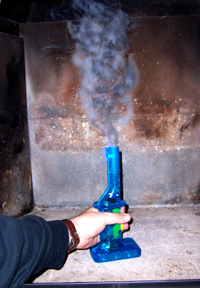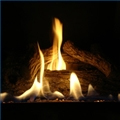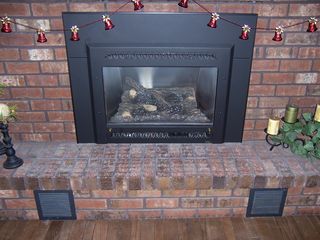
by blogediter | Feb 16, 2018 | Chimney Problems
Smoke Backing Fireplace
Help! Smoke is backing up into my home from the fireplace!
One of the most common issues with fireplaces is they sometimes do not draft well. You open the damper and place your starter paper and kindling properly and ignite the fire…next thing you know you have smoke billowing into your home because the smoke does not want to go up the chimney. When this happens your fireplace is not drafting well.
The damper is open, so why does a smoke backup from my fireplace?
This could be happening for any number of reasons. Your house might be sealed up too tight, or you might have a bathroom or kitchen fan on that is creating back pressure into the house. There might even be a wind outside that is hitting your chimney just right and forcing air down the chimney. Whatever the culprit is, it would be better to know about it before you light the fire.
Know about a draft problem before you light the fire
Wouldn’t it be nice to know if you have a draft issue with your fireplace before you light that fire, so you don’t have the smoke backup? You can use a smoke pencil puffer (sometimes called a smoke stick) to test the draft of your fireplace before you light your fire. By pulling the trigger on a Smoke Pencil it allows you to make a small plume of smoke that will test your fireplace draft, and then immediately you can stop the smoke by releasing the trigger. Just watch the smoke to see if it lifts up the chimney like it should, or if it wafts back into the room. The smoke stick gives you a nice visible controllable smoke that is non-toxic and has a faint sweet smell that fades in seconds.
How much does a smoke pencil cost?
A Smoke Pencil puffer like this costs $25 and will work hundreds of times. If you have ever had to clean and deodorize your home after backing up smoke from the fireplace you know that $25 is a small price to pay to keep this from happening.
What else is a smoke pencil good for?
Besides using them in the fireplace, Smoke Pencils are also used to find air movement drafts in the home due to bad door or window seals, or other small gaps in the homes energy envelope. Home energy raters use Smoke Pencils to test homes for air tightness. HVAC professionals use them to see if they have sealed up a home’s ducts well. You can use them to test your homes HVAC ducts as well and see if you need to tape your ducts to save energy. Click here to buy a Smoke Pencil Puffer

by blogediter | Feb 14, 2018 | Chimney Plugs
Vented gel burner log
Q: I have a small, 100-year-old fireplace that I do not use because the chimney is unlined and I can’t afford to get it lined. There’s no damper either. I have decided to put a fake log and an alcohol gel burner (ventless) in there for the ambiance and a small bit of extra heat. I intend to block off the top of the firebox with a steel plate and fireplace caulk. This should keep air from going up the chimney, but will not stop heat loss via radiation.
Do you think, if I installed a Chimney Balloon 4 to 6 feet above the metal plate, it would survive? These gel burners put out 3000 BTU per hour per can, and I might at times burn 3 cans at a time, for a total 9000 BTU per hour. The flames would not be high enough to touch the metal plate. Thanks, ADH
A: Dear ADH, The Chimney Balloon will trigger its release at about 180-200 degrees Fahrenheit. I am certain it will only take about 5 minutes for a couple of rocket fuel… I mean… gel fuel, canisters to get the flue temp on the other side of your metal plate up to that temp. That metal will conduct pretty well once you get it cooking.
I do want to give you a fair warning about the adaptations you are planning to do to your fireplace. This type of DIY fireplace project is what makes home insurance agents get ulcers. When you self-seals a fireplace flue with a metal plate in order to save heat you are definitely taking your chances. The heat will spill around the lintel of your fireplace and go right up to the mantle and be facing wall. When your mantel clock bursts into flames and your Hummel figurines neatly arranged on the mantle melt from the spilled heat it will be a bit too late to correct the error.
I’m being tongue-in-cheek here, but seriously, altering an existing fireplace to trap heat is not a DIY kind of thing. I don’t even know many fireplace professionals that will try it (unless it is at their in-laws). You might luck out and fix it up just right, and you might create a real safety risk. – Jason
Q: Jason, Thanks for your input about the chimney pillow and the concern about the fireplace adaptation. Before planning to do all this, I consulted specs from several manufacturers for ventless gas logs placed in existing fireplaces.
According to specs, ventless gas logs for this size fireplace, burned with the damper closed, can safely run at considerably more than 9000 BTU given the distance between the top of this particular fireplace opening (which has a hood) and the mantel. The metal plate will be in the same place a damper would be– if there was one– and dampers are metal, so I don’t see the problem. (It will only be touching firebrick and will be several inches back from the fireplace opening, also.)
A number of people in old houses here have had their fireplaces blocked off and big, honking gas logs installed without incident– seems to be standard practice around here anyway.
A: Dear ADH, I am very relieved to hear you researched it fully first, and it sounds like you covered your bases. Good luck with your fireplace project. – Jason
by blogediter | Feb 12, 2018 | Chimney Plugs
There are two types of Chimella. The green one for the standard and purple one which is large. The difference between the two is the handle of the large Chimella is detached while the handle of the standard Chimella is already attached. Don’t forget to read the instruction booklet inside the firebox. Take the Chimella, out of it and push together to make sure that the button is fully pushed up. Try it! Push the button again to close your Chimella and turn it around like a handle bottle grip. Push together firmly and it’s ready to go.

by blogediter | Feb 12, 2018 | Chimney Plugs
My Majestic brand direct vent fireplace is letting in cold air
Q: Jason, I have a vented Majestic fireplace. We do not use it, but it is getting tons of cold air into my house. The vent on the outside of the house doesn’t seem to have any sort of damper on it whatsoever… so closing that is not an option. Right now we have the gas turned off & a blanket over it.
Would a Chimney Balloon help with this? How exactly would we get in to measure the hole? How do we get into the part that has the gas logs?– CG
A: Dear CG, With a few hints in your question, I am assuming that you have a direct vent fireplace, not a gas log fireplace. You say “vent to the outside”, does that mean the vent is a PVC pipe that goes directly through the exterior wall, not out the roof like a chimney?
If it vents through the wall you definitely have a direct vent fireplace.
The good news is, that direct vent gas fireplaces (unlike vented gas logs) generate heat efficiently when running. The bad news is, if the fireplace installer does not take care to insulate the fireplace install correctly it will let in a great deal of cold air when dormant.
If you have not had the original installer over to look at the problem I would try that first. If they stonewall you about it, call an insulation contractor that is forward thinking enough to work with closed cell foam.
You see, a fireplace installer will sometimes slap in a fireplace and think “good enough” but an insulation contractor has a different way of thinking. He will look over an install and consider how it affects the home’s envelope and how he can make an install both safe and tight.
I’m sorry but a Chimney Balloon will not help you on a direct vent fireplace since a firebox is a sealed unit and you can’t gain access to the vent flue and that vent flue is just a small pipe through the wall anyway. – Jason
by blogediter | Feb 12, 2018 | Chimney Plugs
Let’s take a look and see what’s in the box of a standard size Chimella Umbrella. Upon opening the box, you’ll see the color of a standard size Chimella Umbrella which is green. The most important thing is the instruction booklet that you must read. Take the Chimella Umbrella out of it and push together to make sure that the button is fully pushed up. Push the button again to close your Chimella Umbrella and turn it around like a handle bottle grip. Push together firmly and it’s ready to go. Try it!


